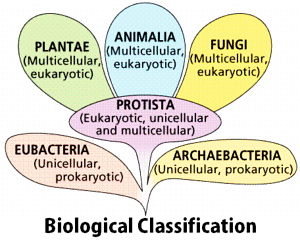Match Column - I with Column - II.Column - I Column - II Saprophyte - Symbiotic association of fungi with plant roots Parasite - Decomposition of dead organic materials Lichens - Living on living plants or animals Mycorrhiza - Symbiotic association of algae and fungi
Choose the correct answer from the options given below :
| Column - I | Column - II | |
| Saprophyte | - | Symbiotic association of fungi with plant roots |
| Parasite | - | Decomposition of dead organic materials |
| Lichens | - | Living on living plants or animals |
| Mycorrhiza | - | Symbiotic association of algae and fungi |
- a - ii, b - i, c - iii, d - iv
- a - ii, b - iii, c - iv, d - i
- a - i, b - ii, c - iii, d - iv
- a - iii, b - ii, c - i, d - iv
The Correct Option is B
Solution and Explanation
Parasite - Grow on/in living plants and animals
Lichens - Symbiotic association of algae and fungi
Mycorrhiza - Symbiotic association of fungi with plant roots
Top Questions on biological classification
- ICBN refers to?
- TS EAMCET - 2025
- Biology
- biological classification
- Which of the following microorganisms is used in the production of curd from milk?
- MHT CET - 2025
- Biology
- biological classification
- In a DNA molecule, which of the following base-pairings is correct?
- MHT CET - 2025
- Biology
- biological classification
- Which is not a prime element?
- MHT CET - 2025
- Biology
- biological classification
- Study the following and pick up the correct combinations:

- TS EAMCET - 2024
- Zoology
- biological classification
Questions Asked in NEET exam
- A body weighs 48 N on the surface of the earth. The gravitational force experienced by the body due to the earth at a height equal to one-third the radius of the earth from its surface is:
- NEET (UG) - 2025
- Gravitational potential energy
A bob of heavy mass \(m\) is suspended by a light string of length \(l\). The bob is given a horizontal velocity \(v_0\) as shown in figure. If the string gets slack at some point P making an angle \( \theta \) from the horizontal, the ratio of the speed \(v\) of the bob at point P to its initial speed \(v_0\) is :

- NEET (UG) - 2025
- Pendulums
- An oxygen cylinder of volume 30 litre has 18.20 moles of oxygen. After some oxygen is withdrawn from the cylinder, its gauge pressure drops to 11 atmospheric pressure at temperature \(27^\circ\)C. The mass of the oxygen withdrawn from the cylinder is nearly equal to: [Given, \(R = \frac{100}{12} \text{ J mol}^{-1} \text{K}^{-1}\), and molecular mass of \(O_2 = 32 \text{ g/mol}\), 1 atm pressure = \(1.01 \times 10^5 \text{ N/m}^2\)]
- NEET (UG) - 2025
- Ideal-gas equation and absolute temperature
- A uniform rod of mass 20 kg and length 5 m leans against a smooth vertical wall making an angle of \(60^\circ\) with it. The other end rests on a rough horizontal floor. The friction force that the floor exerts on the rod is (take \(g = 10\) m/s\(^2\)):
- NEET (UG) - 2025
- Common forces in mechanics
- A wire of resistance \(R\) is cut into 8 equal pieces. From these pieces, two equivalent resistances are made by adding four of these together in parallel. Then these two are added in series. The net effective resistance of the combination is:
- NEET (UG) - 2025
- Resistance
Concepts Used:
Biological Classification
The process of grouping living organisms into categories is called biological classification. The most modern 5-kingdom classification was put ahead by an eminent scientist R.H.Whittaker. The five-kingdom classification is based on the criteria like cell structure, mode of nutrition, body form, and reproduction. One of the most important characteristics of this system is that it follows the evolutionary sequence of living organisms. The organisms are classified into distinct taxa or levels like Kingdom, Phylum, Division, Class, Order, Family, Genus, and Species. The 5 kingdoms are as follows:
